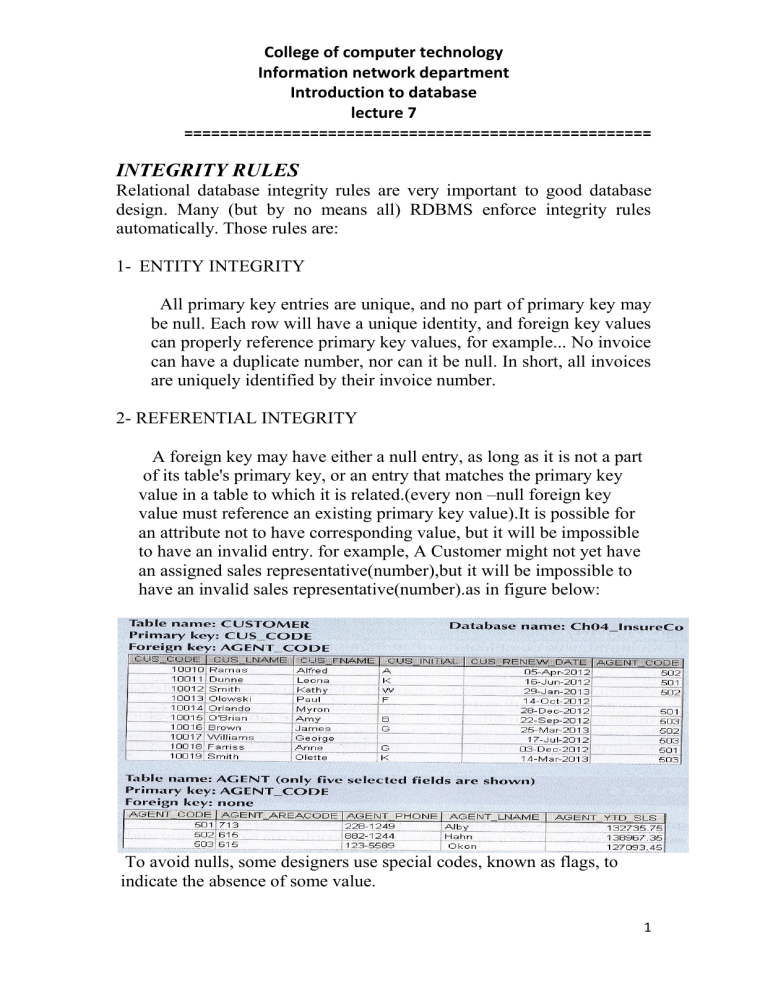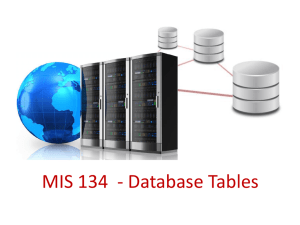College of computer technology Information network department Introduction to database lecture 7

College of computer technology
Information network department
Introduction to database lecture 7
====================================================
INTEGRITY RULES
Relational database integrity rules are very important to good database design. Many (but by no means all) RDBMS enforce integrity rules automatically. Those rules are:
1ENTITY INTEGRITY
All primary key entries are unique, and no part of primary key may be null. Each row will have a unique identity, and foreign key values can properly reference primary key values, for example... No invoice can have a duplicate number, nor can it be null. In short, all invoices are uniquely identified by their invoice number.
2- REFERENTIAL INTEGRITY
A foreign key may have either a null entry, as long as it is not a part
of its table's primary key, or an entry that matches the primary key
value in a table to which it is related.(every non –null foreign key
value must reference an existing primary key value).It is possible for
an attribute not to have corresponding value, but it will be impossible
to have an invalid entry. for example, A Customer might not yet have
an assigned sales representative(number),but it will be impossible to
have an invalid sales representative(number).as in figure below:
To avoid nulls, some designers use special codes, known as flags, to
indicate the absence of some value.
1
College of computer technology
Information network department
Introduction to database lecture 7
====================================================
Other integrity rules that can be enforced in the relational model are the
NOT NULL and UNIQUE constraints. The NOT NULL constrain can be placed on a column to ensure that every row in the table has a value for that column the UNIQUE constraint is a restriction placed on a column to ensure that no duplicate values exist for that column.
Relational set operators
The data in relational tables are of limited value unless can be manipulated to generate useful information. This section describes the basic data manipulation capabilities of the relational model. Relational algebra defines the theoretical way of manipulating table contents using the following operators:
1.
UNION
Combines all rows from tow tables, excluding duplicate rows.
The tables must have the same attribute characteristics (the columns
and domains must be identical) to be used in UNION.
2.
INTERSECT
Yields only the rows that appear in both tables. Was
True in the case of UNION, the tables must be union-compatible
to yield valid results.
2
College of computer technology
Information network department
Introduction to database lecture 7
====================================================
3.
DIFFERENCE
Yields all rows in one table that are not found in the other
Table; that is subtracts one table from the other, the tables must be
Union-compatible to yield valid results.
4.
PRODUCT
Yields all possible pairs of rows from two tables also known
as the Cartesian product.
3
College of computer technology
Information network department
Introduction to database lecture 7
====================================================
5.
SELECT
Also known RESTRICT, yields values for all rows found in a
table that satisfy a given condition.
6.
PROJECT
Yields all values for selected attributes. In other words
, PROJECT yields a vertical subset of a table.
7.
JOIN
Allows information to be combined from two or more tables,
their are several type of JOIN:
4
College of computer technology
Information network department
Introduction to database lecture 7
====================================================
-
natural join
links tables by selecting only the rows with
common values in their common attributes .It is the result of a
three- stage process: aPRODUCT b. SELECT on output of step a
5
College of computer technology
Information network department
Introduction to database lecture 7
==================================================== c.
A PROJECT on the result of step b yield a single copy of each attribute, thereby eliminating duplicate columns.
-equijoin
Links tables on the basis of an equality condition that compares
specified columns of each table. the outcome of the equijoin does
not eliminate duplicate columns, and the condition or criterion use
to join the tables must be explicitly defined.
outer join a- left outer join yields all of the rows in the CUSTOMER table, including those
that do not have a matching value in the AGENT table.
b- right outer join yields all of the rows in the AGENT table, including those
that do not have a matching value in the CUSTOMER table .
6
College of computer technology
Information network department
Introduction to database lecture 7
====================================================
8.
DIVID
Table81is divided by table 2 to produce table3 . table 1 and 2 both contain CODE but do not share LOC.
To be included in the table3 ,a value in the unshared column(LOC)must be associated (in the dividing table 2) with every value in the table 1.
The only value associated with both A and B is 5.
7




